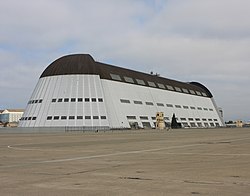
NAS blimp bases, (Navy Air Stations Blimps bases), were United States Navy blimp bases built to protect coastal waters during World War II. Navy Blimps could stay in the air and patrol coastal waters much longer than airplanes. The bases were also called Naval Lighter-than-Air Bases. The blimps (non-rigid airships) were built by Goodyear Aircraft Company of Akron, Ohio. The blimps were powered by two aircraft radial air-cooled engines, the crew worked and on long patrols lived in a car under the envelope. The Navy's anti-submarine warfare operation operated in both the Atlantic and Pacific Ocean. To protect the blimps from strong winds and thunderstorms on the ground most bases had one or more larger airship hangars. Due to the shortage of steel during the war, many hangars were built out of wood. [1] [2] [3]














